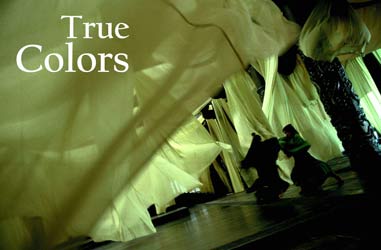
HERO • page 2 • page 3 • sidebar GOLDEN YEARS • page 2 • page 3 DVD • page 2 • page 3 |

 |

Sidebar |
||
When the creative team behind Hero began considering post facilities, they tested labs in Hong Kong, Japan, Thailand and Australia. Although the picture's wire-rig-dependent Wuxia martial-arts style mandated a certain amount of digital post work, the filmmakers planned to achieve the film's vibrant color scheme through photochemical means. "Because the film is about color and color is such a subjective experience, we wanted to have solid ground on which to communicate [with the lab]," says director of photography Christopher Doyle, HKSC. "We also wanted to see how we could use texture - the intrinsic contrast, grain and saturation of different stocks - to enhance the various colors." The lab tests involved force-processing Fuji and Kodak stocks and carrying the results through to an anamorphic blowup and an IP and IN. Upon examining the results, the filmmakers chose Australia's Atlab, where Doyle had recently completed two projects for director Phillip Noyce, Rabbit-Proof Fence (see AC Dec. '02) and The Quiet American. The Sydney-based facility could provide photochemical and digital services under one roof, but what was more important to Doyle was the fact that senior colorist Olivier Fontenay was under that roof as well. The cinematographer had worked with Fontenay on both of Noyce's films and was pleased to sign onto a third collaboration. (At press time, Doyle and Fontenay were working on two more projects, Wong Kar-wai's 2046 and Eros.) "The real challenge [of post work] is to find collaborators of vision and talent and a taste that you can share," Doyle emphasizes. "They have the same machines in Beijing and Mumbai. They don't have the same people." Doyle and Fontenay's creative bond was especially important on Hero given the production's far-flung locations. "Theoretically, it was illegal not to process the film in a Chinese lab," the cinematographer notes. "Most of the time we couldn't screen rushes anywhere we were shooting, so we were totally dependent on our rapport with Olivier; trusting his eye and his judgment was the only way we could reassure the director and producers that we were going where I'd claimed we could go." Fontenay's consultations with Doyle and director Yimou Zhang began in prep and continued throughout principal photography, and he made several trips to the set, even when filming was taking place in some of China's most remote regions. "It was a very collaborative effort," says Fontenay. "It was important to communicate how each stock would respond to certain force-processing techniques and filtration, and to discuss how much we could push the color." Through second AC Jasmine Yuen-Carrucan, Doyle stayed in close telephone contact with Fontenay as he refined his approach; the filmmakers occasionally screened Avid dailies - usually at least a week after that footage had been shot - and on one occasion, Fontenay flew to China to screen film dailies for them in a local theater. "I took my light meter with me and checked out the screen before I presented any work," he adds. When they began seeing footage of Hero's green sequences, the filmmakers realized some of it would require digital color-correction. "The green we had chosen in Beijing responded [poorly] to the light we were stuck with in the vast palace set," explains Doyle. Despite the film's bold color palette, however, the application of those newer technologies was actually quite subtle. The most complicated task involved grading the palace interior, where Broken Sword confronts a number of adversaries. "The green palace sequence involved changing the color of certain parts of the image - curtains only - and rotoscoping the entire sequence and creating mattes at 4K resolution," says Fontenay. "The sequence is just over eight minutes long and involves more than 120 shots, and it took more than six weeks to complete with a team of five working full time - including our digital supervisor, Robert Sandeman, who had to manage a huge amount of data every day." Another green sequence, an exterior scene set at a lake, was digitally graded just as selectively. "We changed the color and contrast of the water but left the background as it was originally photographed," says Fontenay. For the digital color correction, the Atlab team used an Imagica XE Scanner to scan the footage and then graded the images on their standard workstations, "which all run Shake with some in-house modifications that make it easier to color-correct," according to Atlab general manager Anthos Simon. The files were recorded out to Kodak 5242 with an Arrilaser film recorder. (Original release prints were made on Fuji 3513D, but AC was unable to confirm the stock for U.S. release prints at press time.) In all, about 20 minutes of Hero was digitally graded, according to Fontenay. Doyle was on site for much of this work, and what impressed him far more than the technology at hand was the care with which it was applied: "Olivier and the team were like kids in a sandbox, taking incredible pain and pride in doing something so complex so transparently." - Rachael Bosley Sidebar
|
||

